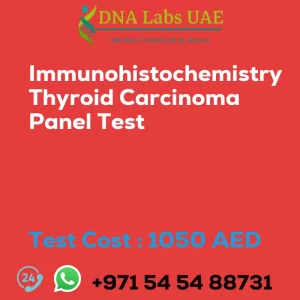FISH – C-MYC AMPLIFICATION Test
Test Name: FISH – C-MYC AMPLIFICATION Test
Components: Price: 1010.0 AED
Sample Condition: 5 mL (3 mL min.) whole blood OR 4 mL (2 mL min.) Bone Marrow from 2 Green Top (Sodium Heparin) tubes. Ship at 18-22°C. DO NOT FREEZE.
Duly filled Chromosome & FISH analysis Requisition Form (Form 17) is mandatory.
Report Delivery: Sample Daily by 4 pm; Report 4 days
Method: FISH
Test type: Lymphoma
Doctor: Oncologist
Test Department: CYTOGENETICS
Pre Test Information: Duly filled Chromosome & FISH analysis Requisition Form (Form 17) is mandatory.
Test Details:
The FISH (Fluorescence In Situ Hybridization) C-MYC amplification test is a diagnostic tool used in cancer research and clinical practice to detect amplification of the C-MYC gene. C-MYC is a proto-oncogene that plays a critical role in cell growth and proliferation. Amplification of the C-MYC gene is frequently observed in various types of cancer, including breast, lung, colorectal, and prostate cancer. It is associated with aggressive tumor behavior and poor prognosis.
The FISH C-MYC amplification test involves the use of fluorescently labeled DNA probes that specifically bind to the C-MYC gene region. These probes emit a fluorescent signal that can be visualized under a fluorescence microscope. By counting the number of fluorescent signals, the test can determine if there is an increased number of C-MYC gene copies, indicating gene amplification.
The FISH C-MYC amplification test is commonly used in conjunction with other diagnostic tests, such as histopathology and molecular profiling, to provide a comprehensive assessment of cancer patients. It helps in stratifying patients into different risk groups, guiding treatment decisions, and predicting treatment response.
Overall, the FISH C-MYC amplification test is a valuable tool in cancer diagnosis and management, providing important information about the genetic alterations driving tumor growth and helping clinicians tailor treatment strategies for individual patients.
| Test Name | FISH – C-MYC AMPLIFICATION Test |
|---|---|
| Components | |
| Price | 1010.0 AED |
| Sample Condition | 5 mL (3 mL min.) whole blood OR 4 mL ( 2 mL min.) Bone Marrow from 2 Green Top (Sodium Heparin) tubes. Ship at 18-22?\u00f8C. DO NOT FREEZE. Duly filled Chromosome & FISH analysis Requisition Form (Form 17) is mandatory. |
| Report Delivery | Sample Daily by 4 pm; Report 4 days |
| Method | FISH |
| Test type | Lymphoma |
| Doctor | Oncologist |
| Test Department: | CYTOGENETICS |
| Pre Test Information | Duly filled Chromosome & FISH analysis Requisition Form (Form 17) is mandatory. |
| Test Details |
The FISH (Fluorescence In Situ Hybridization) C-MYC amplification test is a diagnostic tool used in cancer research and clinical practice to detect amplification of the C-MYC gene. C-MYC is a proto-oncogene that plays a critical role in cell growth and proliferation. Amplification of the C-MYC gene is frequently observed in various types of cancer, including breast, lung, colorectal, and prostate cancer. It is associated with aggressive tumor behavior and poor prognosis. The FISH C-MYC amplification test involves the use of fluorescently labeled DNA probes that specifically bind to the C-MYC gene region. These probes emit a fluorescent signal that can be visualized under a fluorescence microscope. By counting the number of fluorescent signals, the test can determine if there is an increased number of C-MYC gene copies, indicating gene amplification. The FISH C-MYC amplification test is commonly used in conjunction with other diagnostic tests, such as histopathology and molecular profiling, to provide a comprehensive assessment of cancer patients. It helps in stratifying patients into different risk groups, guiding treatment decisions, and predicting treatment response. Overall, the FISH C-MYC amplification test is a valuable tool in cancer diagnosis and management, providing important information about the genetic alterations driving tumor growth and helping clinicians tailor treatment strategies for individual patients. |








